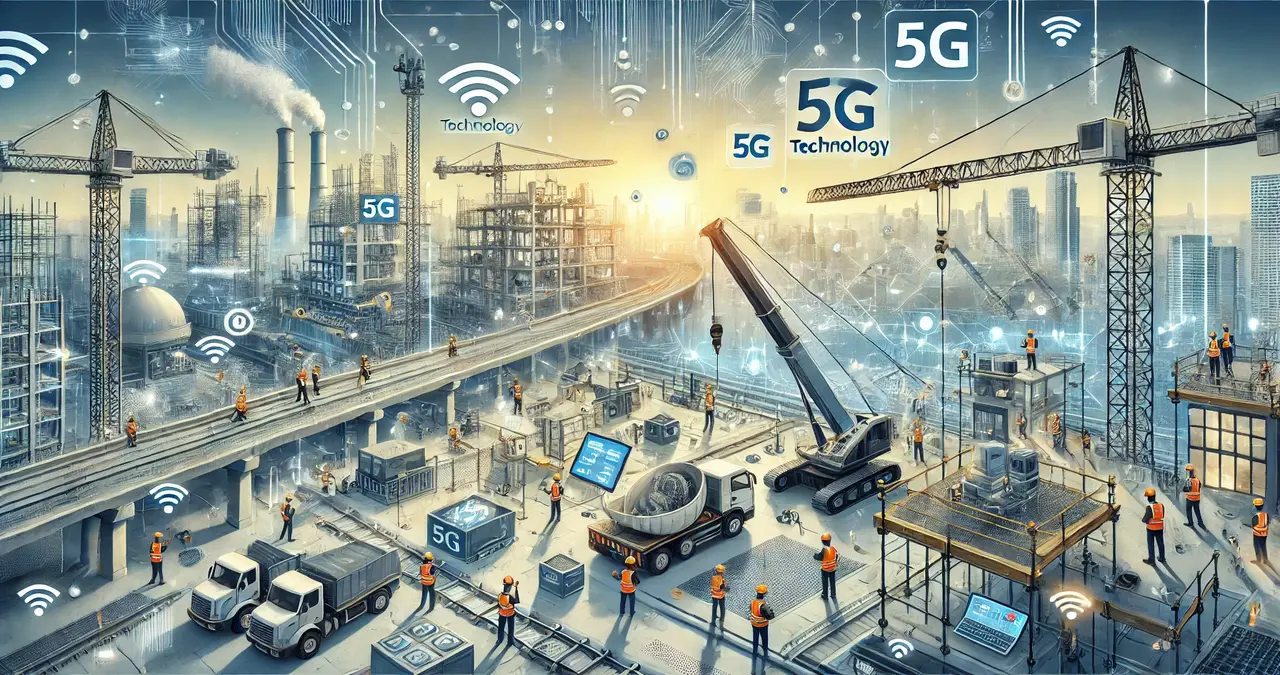Table of Contents
ToggleIntroduction
In the dynamic world of construction, the introduction of 5G technology marks a transformative era. As the industry grapples with complex designs, tight schedules, and increasing demands for efficiency and safety, the advent of 5G promises to bring about a seismic shift in how building projects are managed and executed. This article explores the pivotal role of 5G technology in revolutionizing the construction sector, highlighting its impact on connectivity, efficiency, and overall project management.
Understanding 5G Technology in Construction

5G Technology, the fifth generation of mobile networks, surpasses its predecessors by offering significantly higher speed, reduced latency, and greater capacity. In the context of construction, these capabilities translate into improved communication and data transfer across construction sites, which are often sprawling and segmented.
Enhanced Real-Time Data Transfer
The core advantage of 5G in construction lies in its ability to facilitate real-time data transfer. With 5G, the time taken to send and receive data packets is drastically reduced. This improvement is crucial for construction managers who rely on up-to-the-minute data to make informed decisions. For instance, Internet of Things (IoT) devices can stream data continuously to monitor structural integrity, track construction progress, and ensure that projects adhere to planned specifications.
IoT and Sensor Integration
The integration of IoT with 5G technology in construction brings forth an unprecedented level of automation and monitoring. Sensors placed on various parts of a construction site can measure variables such as temperature, pressure, and humidity and send this information in real time to central systems. This integration allows for proactive maintenance and immediate response to any anomalies or safety concerns, which can significantly mitigate potential risks and delays.
Augmented Reality (AR) and Virtual Reality (VR)
Augmented Reality (AR) and Virtual Reality (VR) are set to benefit immensely from 5G’s low latency and high speed. AR can be used to visualize architectural designs and changes on-site, overlaying digital information in the real world, which can enhance accuracy and reduce errors during construction. Similarly, VR can be employed for virtual walkthroughs with stakeholders who are unable to visit the site, providing a 360-degree view of the project’s progress.
Remote Operation of Machinery
Another groundbreaking application of 5G in construction is the remote operation of machinery. With 5G’s low latency, operators can control heavy machinery from a distance in real time, reducing the need for physical presence in potentially hazardous areas. This not only improves safety but also enhances precision in tasks such as excavation and material handling.
Building Information Modeling (BIM)
Building Information Modeling (BIM) technologies greatly benefit from 5G connectivity. BIM involves the generation and management of digital representations of places’ physical and functional characteristics. Enhanced 5G connectivity ensures that BIM data is updated in real-time and shared promptly with all stakeholders, ensuring all parties are informed of any changes or updates. This synchronization can lead to a reduction in construction time and costs through better coordination.
Challenges and Considerations
While 5 G’s advantages in construction are significant, some challenges and considerations need addressing. Deploying 5G infrastructure itself is a major undertaking, requiring significant investment. Additionally, ensuring cybersecurity in an increasingly connected environment becomes paramount, as the risk of data breaches and other security threats could increase.
Future Outlook
The potential of 5G technology to transform the construction industry is immense. As the technology matures and becomes more widespread, its integration into construction processes will likely become the standard. The future may see even more advanced uses of 5G, from the use of AI for predictive analysis and maintenance to more sophisticated AR and VR applications for training and development.
Conclusion
The integration of 5G technology into construction represents a significant leap forward for the industry. By enabling high-speed, real-time connectivity, 5G facilitates a range of innovative applications that promote efficiency, safety, and reliability. As the construction industry continues to evolve, the adoption of 5G technology is poised to provide substantial benefits, reshaping the way construction projects are planned, executed, and delivered.
FAQS
Here are five FAQs based on the article “Construction Connectivity: How 5G Technology is Accelerating Building Projects”:
What are the key benefits of 5G technology in construction?
The key benefits of 5G technology in construction include:
- Enhanced real-time data transfer.
- Improved connectivity for IoT devices and sensors.
- Better utilization of augmented and virtual reality.
- Remote operation of machinery.
- More efficient use of Building Information Modeling (BIM).
How does 5G improve safety on construction sites?
5G improves safety on construction sites by enabling the real-time operation of IoT sensors that monitor conditions such as temperature, pressure, and structural integrity. This allows for immediate detection of hazardous conditions and quick response to potential safety issues. Additionally, the ability to remotely operate machinery reduces the need for human presence in dangerous areas.
What are the challenges associated with implementing 5G in construction?
The main challenges include:
- The high cost of deploying 5G infrastructure.
- The a need for extensive training for personnel to adapt to new technologies.
- Heightened cybersecurity risks due to increased connectivity and data transfer.
Can 5G technology in construction reduce project costs?
Yes, 5G can help reduce project costs by improving communication and data flow, which enhances project management efficiency, reduces errors and reworks, and shortens project timelines. Additionally, the automation and precision in tasks enabled by 5G can further decrease labour costs and waste materials.
What future advancements in construction might be enabled by 5G?
Future advancements could include:
- More sophisticated uses of AI for predictive maintenance and real-time decision-making.
- Enhanced AR and VR applications for training and safety simulations.
- Even greater automation in construction processes through advanced robotics and machine learning algorithms.















